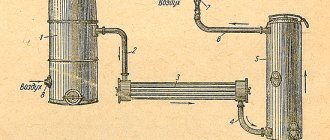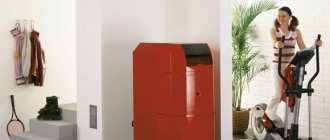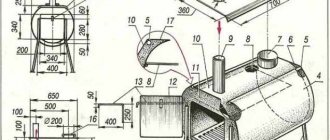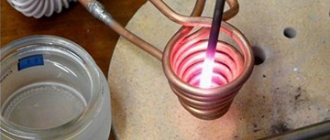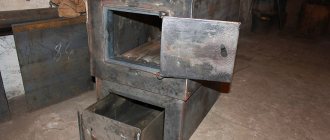The quality of the steam room depends on many factors, including how correctly the heating equipment is chosen. You can build a boiler for a bath with your own hands or buy a ready-made one, welded from Chinese sheet metal, with a minimum margin of safety and many imperfections. The first option looks more attractive, especially since it is possible to implement the most interesting ideas noticed in industrial designs.
Suitable boiler model for a bath
First of all, you will need to find or plan on your own the most optimal option for a boiler and heating installation. It is not difficult to assemble a sauna boiler with your own hands; you only need a minimum set of plumbing tools, a welding machine and cutter, sheet metal and steel pipes. A more difficult problem will be choosing your own drawings for a boiler in a bathhouse. At this stage of work, difficulties always arise with the characteristics and design of the boiler installation.
As a sample of a wood-burning boiler for a bathhouse, you can use two types of heating stoves:
- A low-power stove-boiler with 4-5 kW of heat, designed to heat a small steam room with an area of 4-5 m2 and produce 40 liters of boiling water;
- A large wood-burning boiler-stove with a thermal power of at least 20 kW, designed to heat a full-size steam room of 7 m2 and heat water in a volume of up to 70 liters.
For your information!
Boilers of intermediate power, from 5 to 12 kW, for any bathhouse, including for a summer house or suburban area, can be obtained by simply scaling, increasing or decreasing the model you like. The two diagrams of boiler and furnace installations given below differ from each other in design, housing layout, organization of the combustion process and water heating for the needs of the bathhouse. Therefore, before making a boiler for a sauna with your own hands, it would be right to thoroughly understand all the details and determine how suitable the chosen option is for a steam room of a specific layout.
Instructions for making a boiler for a bathhouse with your own hands
They start by determining the shape and dimensions of the device and choosing materials. The most difficult thing is to make a boiler for a bath with your own hands from sheet iron. More often they take a suitable barrel or a fragment of a pipe and remake it. It is important to choose the right size. So, for a bathhouse with an area of no more than 12 square meters. m will be enough equipment made from a 200-liter container. You can take a barrel for diesel fuel or gasoline. A 70-100 cm piece of pipe with a diameter of at least 50 cm is also suitable for such a modification.
Important point. The metal used is thick-walled, otherwise it will quickly burn out. 5 mm steel is chosen for the walls, 10 mm for the bottom. In addition to the workpiece, for assembly you will need fittings for furnaces, a tube for making a heat exchanger, a chimney pipe, an angle or fittings for grates, and a channel. You will need another brick to create a protective screen. We will analyze in detail the process of making a boiler for a bath from a pipe with our own hands.
Marking the structure
The first stage is marking the workpiece. We need to outline four cameras. The lowest one is the ash pan, its height is about 100 mm. Then comes the combustion chamber with a height of 360-400 mm. A heater is placed above it, to which another 400 mm is allocated. Above is the tank, which leaves 400-600 mm. Marking is necessary for the subsequent division of the workpiece into compartments. Restrictors are welded to the designated areas; they can be made from 12 mm reinforcing bar.
Later, metal partition parts are installed on these limiters. They are cut according to the internal dimensions of the body. Grate grates are placed at the bottom of the combustion compartment. After the limiters are installed, the bottom is welded to the workpiece. The seam must be of high quality and sealed. Then the supports are made from channel scraps. They are secured by welding to the bottom of the structure.
Instagram strannik962
Assembling the ash pan and firebox
Three compartments, counting from the bottom, are equipped with doors. Holes are cut out for them. The first is in the ash pit. This is where the door to the ash pan is secured. On the same line with it, but above, a hole is placed for the combustion door. They are bought in advance, but you can do it differently. Then the fragments cut out from the body are used as doors. A handle and hinges are attached to them. This makes it cheaper, but more difficult to manufacture.
The hole for the heater door is cut in the third compartment from the bottom. It is optimal to make a door connected to the neck; it is inserted into the partition between the steam room and the washing room. This will make it convenient to pour water on the heater to get steam. After this, they begin to prepare the grate. It is welded from reinforcing bars or a sheet of metal with perforations is taken. The dimensions of the perforation must be sufficient to allow air to pass into the combustion compartment and ash to spill out.
The grate bars are cut in the form of a round plate. Its diameter should be equal to the diameter of the inner part of the housing. The grate prepared in this way is placed on a support between the combustion chamber and the ash pit. There is no need to fix it by welding; the grates should simply lie on the support. A heat exchanger is installed inside the combustion chamber and secured in place. A metal partition with a hole is installed above the combustion chamber, to which the chimney is attached.
Let's make a vent. The easiest way is to cut a thick-walled pipe of suitable dimensions in half. It is cut lengthwise and inserted into the compartment. Guide rails are prepared for it. The part moves along them, but is not completely removed.
Instagram dolganov_dmitrii
Installation of a boiler for a bath
Before planning to make a boiler for a bathhouse, you need to decide on the material for the stove. The developers of the small-sized boiler designed the construction of the firebox body and heater from thin, only 0.8 mm, sheet stainless steel grade X18N9T. If alloy steel with a high content of titanium and manganese is used, then you will need to think in advance about what and how to weld the boiler for the bath, and look for welding equipment such as a plasma cutter or argon. Welding work on thin stainless steel sheets will require the experience of a welder.
Advice! If you cannot find high-quality stainless steel, then the boiler can be made from structural steel up to 2 mm thick, followed by the application of a heat-resistant coating.
The service life of a stainless steel boiler is up to 12 years; a ferrous metal casing burns out in 4-5 years.
The boiler design consists of the following parts:
- The combustion chamber is a box measuring 800x350x600 mm; the size of the body allows the stove to be transported in the trunk of a car without restrictions;
- Chimney with flame arrester. Due to the short stroke of the flame inside the combustion chamber of the boiler, sparks and embers are thrown out of the chimney by a stream of gases, therefore, to preserve the bathhouse, installing an intermediate chamber on the boiler is considered mandatory;
- Metal double tank for hot water with pipelines and a heat exchanger built into the boiler firebox.
For your information! In this version, a tank with a capacity of 100 liters is provided for water. This is more than enough to provide hot water to both the washing compartment of the bathhouse and to fill the heating system. During the summer, a small tank of 30-40 liters is used in the bathhouse.
Thanks to its thin walls, the boiler warms up the room of a small bathhouse in 25-30 minutes, while the water in the tank heats up to 70°C for more than an hour, so in winter, heating begins by heating the water supply over low heat. This makes it possible to remove from the bathhouse all odors remaining from the previous washing. After the tank has heated up to a temperature at which it is impossible to keep your hand on its surface, you can build a fire in the stove at full power. Stainless steel walls do not burn, so even with the boiler operating at maximum power, there are no smells of burnt metal in the bathhouse.
Barrel stove
How to choose boilers for baths? What material should be used for their production?
Such decisions should be made independently, taking into account the availability of components. Some people find it more convenient to use sheet iron, while others think that it is better to make boilers for a bathhouse with your own hands from a barrel or pipe. They are no different and boast the same heating of water in containers and the room as a whole. The difference lies in the method of production.
To be fair, it must be said that it is much easier to make a boiler for a bathhouse with your own hands from a barrel. This is the simplest design. All you need is to find a metal container with a wall thickness of at least 0.3 centimeters. Thinner metal will burn quickly.
You need to make a boiler for a wood-burning sauna from a barrel in the following order:
- The bottom of the container is completely cut out. Instead, a sheet of iron with a thickness of at least 0.5 centimeters is installed. It is necessary to weld the legs to it in advance, which can be made from scraps of a T-beam.
- At a height of 5–7 centimeters from the bottom, you need to cut out a small window (approximately 20x15 cm). The blower door will be installed at this location. It is made from a sawn piece. You need to weld the hinges and handle to it, and then install it in its rightful place.
- The second door of the future boiler for a wood-burning sauna is installed 20 centimeters above the vent. It should be significantly larger than the first one (approximately 25x45 cm). Otherwise, the logs will not fit into it.
- A boiler for a wood-fired sauna contains grates in its design. They need to be placed 5–7 centimeters below the firebox door.
- A heater must be placed above the firebox. The most convenient place for its location is the second third of the barrel. The partition between these sections of the boiler should not be continuous. It is made from channels. The size of the heater is equal to the second third of the barrel. A door is needed in the middle of the heater. Stones are laid through it and water is poured in, if desired, to “give it to the park.”
- From a barrel you can make a boiler for a sauna with a tank. To do this, use the remaining third of the barrel. The heater and tank are separated by a solid partition, the seams are thoroughly boiled. A chimney pipe must be installed in the center of the tank.
Having studied the drawings of such structures, you can easily build a stove. There's nothing complicated about it. All you need to make a sauna cauldron with your own hands is to strictly follow the existing instructions. Before operation, the manufactured sauna boiler must be cleaned of scale and rust.
If desired, it can be painted with heat-resistant paints and varnishes. That's all. A DIY cauldron made from a barrel is ready. It can be installed in a bathhouse.
Heating into a bathhouse from a pipe is done in the same way. The only exception is the initial stage. You will not have to cut out the bottom of the barrel, but you will need to maintain the dimensions by cutting a pipe 1.2–1.4 meters long.
The principle of operation of a boiler installation for a bath
Inside the combustion chamber there is a U-shaped heat exchanger made of alloy steel. It will be quite difficult to bend a stainless steel pipe on your own, so it is best to buy this unit ready-made or have it made in a workshop.
There is no additional horizontal shelf in the combustion chamber, which is used to lengthen the flow of hot combustion products. The “tooth” function is performed by a heat exchanger, so the water inside the pipe heats up very quickly. The “horseshoe” itself inside the chamber is not located strictly horizontally, but with a lateral slope; in addition, a column of water from the tank presses on the liquid inside the heat exchanger. Thanks to this device, there are no vapor locks inside the tubular heat exchanger. When the tap is opened, the bathhouse visitor can safely draw hot water without the risk of being burned by overheated steam.
The boiler firebox can be made without a blower or ash pan at all; instead of an additional compartment, a dozen holes are drilled below the chamber door, or an adjustable air supply valve is installed.
Installation recommendations
Long before making a boiler for a bath, you need to decide on the location and diameter of the chimney pipe. The design of a homemade stove should take these points into account, so that later you don’t have to make several turns of the chimney, which will affect its service life. If you decide to place a tank for heating water on a pipe, then it should rise straight up and go through the roof. Starting from the ceiling lining and until the very end, it is recommended to use two-layer sandwich pipes for the chimney. The temperature of the flue gases in it is quite high, so the pipe should not be in direct contact with the elements of the ceiling and roof. A detailed diagram of how to install a boiler in a bathhouse is shown in the figure.
Boiler installation
The unit cannot be placed on floors; it requires a foundation in the form of a slab of concrete or brick. Wall surfaces lined with wood that are nearby must be protected from heat flow using screens made of basalt materials. Some homeowners are thinking about how to paint the boiler in the bathhouse in order to improve the interior. There are special industrial high-temperature paints, but their use is impractical. The burning temperature of wood is 600 ºС, any paint will have to be renewed frequently, and its cost is very high. It is better to install a heater on the entire body, as described above, or line the boiler with ceramic bricks.
Article on the topic: How to weld a sauna stove from a pipe
Options for improving a boiler for a bath
Despite the well-thought-out and repeatedly tested design of the sauna stove, many home-made people bring in their own ideas for improving the combustion chamber.
For example, you can use removable side screens in a bathhouse. Two metal sheets, on hooks or removable rivets, help limit heat loss during the initial stage of heating the water in the tank.
If the boiler is used only as a hot water generator for a shower cabin in a bathhouse, then it makes sense to install an air quantity regulator on the combustion chamber vent. In this mode, the boiler can operate at minimum power and meet the needs of bathhouse visitors for hot water for 4-5 hours.
Rectangular boilers
Before making a boiler for a rectangular bath, you need to select sheet metal in the required quantity. Its thickness should be at least 4 mm, but it is better to find alloyed heat-resistant steel. If you don’t have it, you can take a regular one, 5-6 mm thick. To heat a steam room with a volume of 20 m3, the dimensions of the combustion chamber should be approximately 450 x 450 with a height of 600 mm. In this case, we consider a firebox standing vertically. Orientation in space does not play a special role; it all depends on the availability of free space.
Rectangular sauna boiler
Further instructions on how to weld a sauna boiler with your own hands:
- Mark the steel sheet and cut it using a grinder. Cut strip metal into stiffeners, pipes for the air damper and chimney.
- Weld the firebox body. Cut a hole at the bottom of the front for the door, and in the lid for the chimney pipe. Weld the pipe as shown in the figure, as well as the remote channel for loading firewood.
- Weld stiffening ribs from a strip 4 mm thick to all walls of the combustion chamber. In addition to strengthening the structure, the ribs improve heat exchange between the firebox and the room air.
- Fabricate and install a loading door with adjustable hinges and a locking mechanism. A pipe with an air damper can be cut into the body of the door, which will regulate the supply of combustion air.
- Attach the sides for the installation of the upper heater. This design is not mandatory; often the entire boiler is fenced with a net and the space between it and the body is filled to the top with stones.
The principle of assembling a horizontal stove is not much different; it can be implemented by studying the drawing for a boiler in a bathhouse:
Drawing for a boiler in a bathhouse
In this design, the heater is immersed inside the firebox due to a recess on top of the body. The stones will warm up perfectly, but the volume of the combustion chamber is reduced. The installation of a grate and an ash pan door is provided here; in this case, there is no need to embed an air damper into the loading door.
How to properly weld a boiler
Before starting work, it is necessary to cut out the sheet blanks of the combustion chamber body, as well as the heater and chimney. All parts of the sauna stove must be adjusted to the nearest millimeter.
The easiest way to weld a sheet steel body involves the use of an auxiliary frame:
- Initially, you will need to make corners from strips of stainless steel 20x800 mm, from which the frame or frame of the future case is assembled using rivets;
- Individual parts - the side walls, bottom and top shelf of the heater - are laid and secured to the frame using clamps;
- The elements of the combustion chamber laid on the frame are connected by cooking points, after which the seams can be welded using argon welding or a carbon dioxide semi-automatic machine.
This method simplifies the assembly of the boiler and at the same time strengthens the most vulnerable part of the structure - the welding seams. Frame elements and stainless steel corners remaining inside the combustion chamber serve as screens for welding seams. Therefore, according to many craftsmen, joints can be welded semi-automatically using ordinary 0.8 mm carbon wire.
Cylindrical boilers
The easiest way is to make a boiler for a bath from a pipe with thick walls (6-8 mm). You can take a thin-walled pipe, or even an iron barrel, but such a stove will not last long. So, a pipe with a diameter of 400-500 mm up to 1 m in length will be the combustion chamber. The bottom and cover made of a steel sheet with a thickness of at least 5 mm should be welded to it. Such a boiler for a bath can be made without a grate; all operations are performed through the loading door. The external channel for its installation can be made of rectangular or circular cross-section, its length is equal to the thickness of the bathhouse wall.
Boiler in a bathhouse from a pipe
There is a hole in the center of the lid to which the chimney pipe is welded. You can regulate the intensity of combustion by installing a damper in the chimney, which will reduce draft. But more often they make a hole in the door and cut a pipe with a damper into it, as shown in the figure.
Side on the boiler
A homemade boiler for a bathhouse made from a pipe must have a heater, here a special side made of steel 4 mm thick is welded for it. This is the simplest stove model, and the pipe can be positioned horizontally, especially if it has a large diameter. Then the door will need to be installed at the end, and the chimney will need to be welded at the end of the pipe. For stability, you will need to attach supports to the firebox body.
Homemade boiler for a bath
Vertical boiler for heating a bath
For powerful furnaces and boiler installations, a vertical housing layout is best suited. The structure of a furnace made of a pipe with a diameter of 500 mm is shown in the diagram.
Structurally, the heating installation for a bath consists of three chambers. In the lower part there is a firebox and an ash pan, the middle part is reserved for the heater, the upper compartment is made in the form of a tank for boiling water.
Also in the middle part of the boiler body there is a water tank welded for the needs of the bathhouse. Unlike the upper tank, the walls of the tank do not come into direct contact with the hot combustion products. Heat flows into the tank through the backfill layer of the heater; the temperature of the water in the tank does not rise above 70-80°C.
This design of the boiler means that the water in the heating circuit will not boil, even at maximum heating of the bath, which means that, regardless of the filling level, approximately the same temperature will be maintained in the container. Water can be used in the washing department of the bathhouse, or even to heat the rest room.
Types of boilers
Depending on the type of fuel used, the entire variety of modern sauna boilers can be divided into several categories:
- Electric models. They are distinguished by the absence of harmful emissions of combustion products and the absence of the need to install a chimney. They do not require fuel reserves, but during any power outage they become useless.
- Gas boilers. The most economical of all the presented models, provided that the site is already gasified. There is also no need to prepare fuel reserves.
- Solid fuel. The most common type of boiler. During operation, they require periodic loading of new portions of fuel. They are rightly considered the most accessible for independent production.
- Diesel. Liquid fuel is used as a heat source. Due to the complexity of the design, they are not suitable for self-production.
- Pyrolysis (combustion of solid fuel and volatile substances occurs separately).
We recommend that you read: How to make and install a heat exchanger (economizer) for a chimney with your own hands
Installation and assembly work
To make a boiler for heating and heating a bath, you will need a blank of high-pressure steel water pipe, measuring 50 cm in diameter and 1200 cm in length. The first step is to cut out mounting windows in the wall of the future boiler body. In total, you will need to cut four openings with a grinder:
- The largest window, 60x40 cm, is used to install an auxiliary water tank;
- The second largest window is intended for the combustion chamber measuring 40x22 cm;
- The loading opening for laying stones in the second compartment has parameters of 21x20 cm;
- The smallest is a hatch for cleaning the ash pan, size - 10x20 cm.
The next step is to weld round transverse partition walls into the body. To cut the bottom, sheet metal 4-5 mm thick is used. Inserts into the body are welded by electric welding immediately after cutting the windows.
Sawn fireclay brick blocks are laid inside the future combustion chamber. For normal operation of the boiler in the bathhouse, it is enough that the firebox volume is at least 10 liters. One load of firewood into the boiler heats the bathhouse for 40 minutes.
The next step is to weld a chimney pipe into the upper wall of the combustion chamber. This is not easy to do, but it is necessary to weld the chimney immediately and completely along the entire length of the joint, otherwise the flue gases will enter the bathhouse through the heater.
At the last stage, the doors are hung on the firebox and ash pan, the lid is installed on the top of the boiling water container, and the base of the boiler is welded. Experts recommend installing the stove on a brick-lined area, but in steam rooms and high humidity, chamotte and dinas baths quickly collapse. Therefore, bathhouse owners weld a cut-off half of a truck wheel rim to the lower end of the boiler and embed the entire structure in concrete.
After the body has been finally assembled, all seams have been additionally welded by electric welding, and an auxiliary tank with hot water can be installed. It is best to buy a storage tank for a bath ready-made, for example, choose a $50 stainless steel model. Such a tank will not burn out or rust, even if water sits in it all winter and summer.
Construction of homemade boilers
To make your own boiler for a bath, you should arrange in advance to purchase the following tools and materials:
- welding machine,
- Bulgarian,
- pieces of reinforcement,
- a piece of pipe of appropriate length and diameter,
- metal hinges for securing doors,
- tap for hot water tank.
The technology for manufacturing a metal solid fuel boiler of cylindrical and rectangular shape is somewhat different.
Cylindrical boiler
The best material for such a boiler would be a thick-walled (6-8 mm) pipe with a diameter of 400-500 mm.
You can use thinner iron, for example, an ordinary barrel, but the service life of such a boiler will be much shorter.
- A piece of pipe about 1 m long will serve as a combustion chamber. A bottom and a cover made of sheet steel with a thickness of 5 mm or more are welded to this element. To give the boiler stability, you can additionally weld legs from channel sections to the bottom.
- Having retreated 3-5 cm from the bottom of the workpiece, using a grinder, a rectangular hole measuring 10x15 cm is carefully cut out. The cut piece of metal will also come in handy - it will serve as the door of the ash pit and ash pan.
- A handle and hinges are welded to the door, with which it is secured to the boiler body.
- Above the ash pit, 5-10 cm higher than it, a grate is welded into the pipe. In this case, it can simply be a sheet of metal of the appropriate size, with evenly made holes that can easily allow ash to pass through. Instead of a sheet of metal, you can weld several thick pieces of reinforcement.
- Stepping back another 5-10 cm from the grate, another hole is cut out - the firebox door. Its dimensions must be at least 25x40 cm, otherwise it will be inconvenient to lay firewood. The door is also equipped with hinges and a handle, after which it is installed in place.
- A heater will be placed directly above the firebox. Its height is taken to be equal to the height of the firebox itself, and a door is also mounted in its middle part on the steam room side. Through it, stones are laid and hot steam is released.
- A water tank is mounted at the very top of the boiler. Along its entire height, exactly in the center, there runs a piece of pipe with a cross-section of about 100 mm and a height of approximately twice the height of the tank itself, which acts as a chimney. The water will be heated by the movement of hot smoke and hot air from the stones located below. It is worthwhile to provide a hinged lid at the top of the tank, and weld a tap at the bottom.
We recommend that you read: How to properly hide water pipes in the bathroom?
The combustion intensity is adjusted in two ways:
- Using a damper in the chimney (this element can not be found in all types of construction).
- Through a blower combined with an ash pan.
Rectangular boiler
Making a boiler of this shape will require more effort. The workpieces will need to be carefully measured, and a large number of welds will be required to connect the elements.
The best material is heat-resistant alloy steel with a thickness of 4-6 mm. For a steam room with a volume of 20 cubic meters, the optimal dimensions of the finished boiler will be 450x450x600 mm.
Note! The orientation of a rectangular boiler in a room does not play a significant role. A horizontal arrangement will require more space, but will provide better stability. Vertical, on the contrary, will help save space, but may require additional fastening.
- A steel sheet of the required thickness is carefully marked and cut using a grinder. At the same time, you can prepare sections of strip metal that will serve as stiffeners, as well as pipe blanks necessary for installing the chimney and air damper.
- The combustion chamber body is welded from the prepared parts. A hole is cut in the lower part of the body for the firebox door, and in the top for the chimney pipe. Next, the pipe itself and the remote channel are welded (its length should be equal to the thickness of the bathhouse wall), through which firewood will be stored.
- It is recommended to weld additional stiffeners from thick strips of metal or steel angle to the walls of the firebox. These elements will not only help strengthen the structure, but also significantly improve heat transfer in the steam room.
- At the end of the outlet channel, a door is mounted on hinges. Also, the door can be equipped with a damper that allows you to regulate the intensity of the combustion process (such a damper is needed only if the design does not provide for an ash pan).
- The heater can be arranged in several ways. One of them involves welding a metal side around the perimeter of the upper part of the firebox and filling the resulting container with stones. Another method is even simpler - the firebox is wrapped with a metal mesh, and stones are placed in the space between them.
We recommend that you read: How to make your own pipe bender for bending copper pipes
Boiler for a bath made from scrap metal pipes
The easiest way to make a boiler for a wood-burning sauna is to use a piece of durable metal pipe of large diameter. There are two options for making a boiler from metal pipes: vertical and horizontal - both of them have their advantages and disadvantages.
To begin manufacturing, stock up on the following tools:
- Electric machine for metal welding,
- Angle grinder with a set of discs for cutting metal.
Horizontal boiler
In the first method, a piece of metal pipe is laid on the ground and a blind plug is installed on one side of it. On the opposite side, a stove door is installed in the plug. Also, in the area of the blind plug, you can install another jumper, which forms a heating tank for hot water. You can also make a water tank in the upper segment of the stove. In this case, you can make a system of constant water heating, when the used hot water is regularly replaced with newly supplied cool, not heated water.
Boiler diagram using wood from a pipe
In the side part of a horizontally lying pipe or in its upper segment, you can also install a heater, that is, a shelf into which river stone is poured, which will further increase the power of the stove!
Vertical design
On the other hand, the pipe cuttings can also be placed vertically. The entire internal volume of the pipe will be divided into two parts: the firebox itself in the lower part and the tank for heating water in the upper part. When building such a structure, a shelf for stones can be placed on the side.
If the wall thickness of the metal pipe is large, the firebox and tank for heating water can be made separately. This will make it easier for you to handle massive structures. Please note that thick metal is needed only for the manufacture of the firebox, but thinner metal can be used for the heating tank. The thickness of the metal used to make the firebox directly determines its further service life: the thicker the walls, the longer the period of trouble-free operation.
A heater, that is, a shelf for stones in this design can also be placed between the heating tank and the firebox. The chimney pipe is mounted strictly in the center of the firebox. Be especially careful when welding the junction of the chimney pipe with the firebox and heating water tank. For efficient operation of the stove in the pipe, it is recommended to install an adjustable damper.
The chimney pipe in such a boiler using solid fuel can also be made of combined materials, for example, steel and asbestos. During installation, when connecting metal and asbestos pipes, be sure to take into account the different coefficients of thermal expansion of these materials when they are heated.
Such boilers made from scraps of thick-walled metal pipes will faithfully serve you for several years until you decide to replace them with a more permanent and expensive structure. Yes, even if you don’t decide to replace it, everything will function perfectly!
Kinds
Sauna boilers can be made independently from a barrel or from metal sheets. Each of them will be discussed below.
- Boilers made from barrels. Sauna boilers made from a barrel are compact stoves, the main element of which is a barrel with a volume of at least 200 liters. It should be noted that the barrel must be Soviet-made, since they are much stronger than modern ones. The same barrel is divided into two parts by a special partition. In the lower part there is a firebox, under which there is an ash pit with a palace. The upper part is a water heating tank. There is a hole in the partition that separates the water tank from the firebox through which the chimney passes. At one end it is connected to the firebox, and at the other end it goes outside through the partition and the layer of water in the tank. The heater, where the stones are located, is located on the side as close as possible to the firebox for efficient heating.
- Boilers made of metal sheets. Such furnaces have a similar structure to barrel boilers, but unlike them, they have a quadrangular cross-section. In general, sheet metal furnaces consist of three sections:
- Water heating tank. He is located above everyone else. A chimney pipe passes through this tank, as in the case of barrel stoves.
- Kamenka. It is located below the water heating tank. There are stones here. The walls of this section are lined from the inside with a fire-resistant layer of brick. This layer is called a lining.
- Combustion chamber. It is the lowest section of the structure. There is also a lining here. This section is further divided into two parts. The upper part is the firebox itself, and the lower part is the ash pan. The partition between them is made of a metal lattice.
Boilers for baths can also be classified according to the type of fuel they operate on. So, the following types are distinguished:
- Gas units. Such boilers run on gas, and would be an ideal option if the house has a gas supply system. Such units themselves are very compact and take up little space. In addition, they do not emit any odors or waste. There are three types:
- Single-circuit. Such units are designed to heat a small bathhouse.
- Dual-circuit . They are designed to heat a bath and a small amount of water.
- Three-circuit. They can heat a radiant floor system and also heat a small swimming pool.
- Electrical. If gas is not supplied to the house, then you can purchase electric boilers that operate on electricity. The undoubted advantage of such units is that they can be adjusted to a specific temperature. They are also environmentally friendly, as they do not emit any waste. Despite these advantages, these units still have one main drawback - increased energy consumption. Electricity is currently becoming more expensive, so not everyone can afford such a structure.
- A solid fuel unit is also a good option for baths. But they do not have an automation system, that is, they cannot work in automatic mode. Therefore, you will have to approach each time and load a certain portion of fuel. Modern boilers are manufactured in such a way as to extract as much heat as possible from the fuel. To this end, the thermal insulation of solid fuel boilers continues to be improved to reduce heat loss.
- Units running on diesel fuel. Such boilers are very convenient to use, since they can be refueled once every six months or a year. The most important thing is to find a special container for storing diesel fuel. Some people buy large quantities of fuel and store them underground, refueling the unit once a year. Such a unit requires a separate room, and all work related to the installation and repair of such boilers should be left to an experienced specialist.
- Pyrolysis boilers. Such units mainly run on wood. Unlike conventional stoves, they have two combustion chambers. In the first chamber, the firewood is exposed to high temperatures without air access, where it decomposes, releasing gas. This gas is collected and sent to the second firebox, where it burns. In this way, combustion of fuel without residues is achieved. The main disadvantage is the high price.

